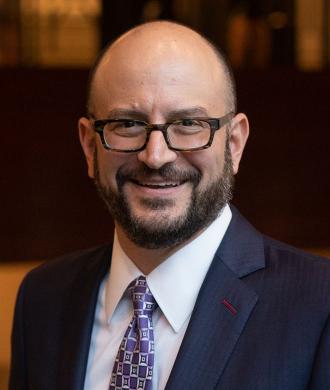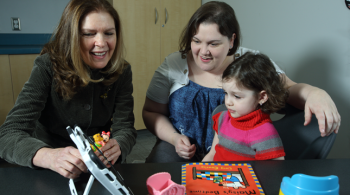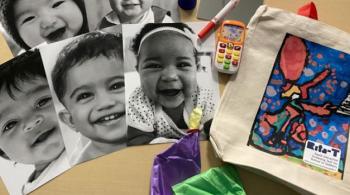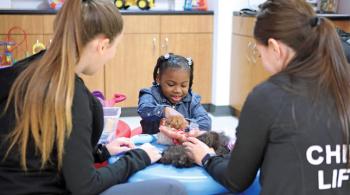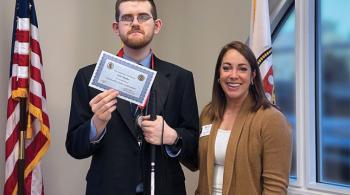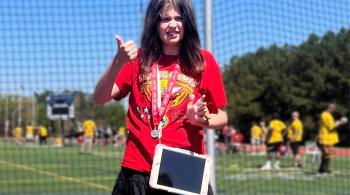;
Early recognition of hearing loss–whether an individual has complete loss or is hard of hearing–has significant implications for optimizing outcomes for communicative functioning, whether it’s an intervention to restore hearing, learning to use sign language, implementation of alternative or augmentative forms of communication, early detection is key.
On this month’s episode, Dr. Bradley Schlaggar, president and CEO of Kennedy Krieger Institute Is joined by his colleagues: Dr. Katheryn Boada, director of Speech-Language Pathology and Assistive Technology and Dr. Amy Gaskin, director of Audiology, to talk about the connection between hearing and the development of speech and language in children.
Learn More About Our Featured Speakers
Learn More About Our Featured Speakers
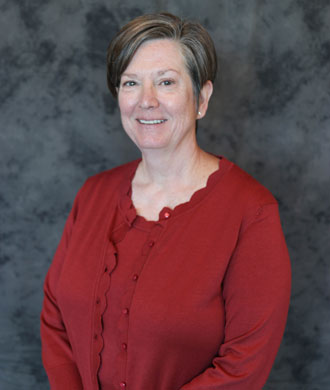
Amy Gaskin, AuD, CCC-A
View Episode Transcription
Dr. Bradley Schlaggar (BS): Welcome to Your Child's Brain, a podcast series produced by Kennedy Krieger Institute with assistance from WYPR. I'm Dr. Brad Schlaggar, pediatric neurologist, and President and CEO of Kennedy Krieger Institute. While hearing difficulties may be most commonly associated with adults, especially as we get older, hearing loss affects people of any age, including newborns, infants, and children. To put prevalence rates in perspective in the U.. S, around 15% of adults have hearing difficulties and that rate increases with age, such that for people over the age of 65 years, the rate is around 25%. Now, by contrast, roughly two out of 1,000 newborn babies, that's 0.2%, screens positive for hearing loss, and roughly five out of 1,000 children ages 3-17 years has hearing loss. That's about 0.5%. Genetic or inherited causes explain about half of all newborn and pediatric hearing loss. Other causes include maternal infection during pregnancy and other perinatal factors, including prematurity and very low birth weight. Chronic exposure to high decibel noise can lead to hearing loss. Middle ear infection, or so-called otitis media, is a cause of hearing loss at any age, but is especially problematic during infancy and early childhood, because of the critical role that hearing plays on the development of speech and language. It's that connection in early childhood between hearing and the development of speech and language, which will be the focus of our discussion today. Our brains evolved for spoken and heard language, and they rely on early exposure to heard language for the development of typical language to take place. Atypical language development can negatively influence reading development, language comprehension, academic success, and social interactions. Early recognition of hearing loss, whether an individual has complete loss or is hard of hearing, has significant implications for optimizing outcomes for communicative functioning, whether it's an intervention to restore hearing, learning to use sign language, implementation of alternative or augmentative forms of communication, early detection is key. Today we're going to talk about the connection between hearing and the development of speech and language with two of my expert colleagues from Kennedy Krieger. I'm joined by Dr. Katheryn Boada. She's the director of Speech Language Pathology and Assistive Technology at Kennedy Krieger. Dr. Amy Gaskin, she's the director of Audiology at Kennedy Krieger. Welcome Kathy and Amy. Let's start by talking about two closely related yet distinct clinical disciplines, audiology and speech language pathology. Can you define them and discuss how they're related, Amy?
Dr. Amy Gaskin (AG): Audiology is the science or the study of hearing balance and its related disorders. Audiologists are healthcare professionals who evaluate, diagnose, treat, and manage hearing loss and balance disorders in individuals of all ages across the lifespan.
Dr. Katheryn Boada (KB): Speech language pathology is that healthcare field that specializes in the prevention, assessment, diagnosis and treatment of speech, language, cognitive communicative voice and swallowing disorders. Audiologists and speech pathologists are sister professions. We have the same foundational training in hearing speech and language development, and we often work together to support a child's communication needs.
BS: The word infant comes from the Latin infantia, which means without language. What's the role that hearing plays in the typical development of speech and language in infancy, and how does that change play out over the course of development?
KB: An infant's not born speaking. They are immediately attuned to that their caregiver's face and voices around them. They start to engage in vocal play. They mimic the sounds they hear, the cadence of speech around them, and that's how their natural and native language develops. Hearing continues to be important as speech and language development. The young child needs to not only be able to distinguish speech sounds, but also that intonation and tone of our sentences. Because often, how we say a phrase changes its meaning or conveys our intention. Is this a question or a statement? Is the speaker happy, surprised, angry, confused? Attending to these subtle nuances is just as important to understanding the meaning of words as learning the speech sounds.
BS: Amy, what's the importance of screening a newborn for hearing issues, and how do you actually go about screening or testing a newborn?
AG: We all know that hearing loss can have a very significant impact on a child's ability to develop speech, language, social skills and the earlier the children with hearing loss are getting into services, the more likely they are to reach their full potential. In order to do that, we need to screen every newborn as soon as possible, following the EHDI guidelines. EHDI stands for Early Hearing Detection and Intervention. This EHDI program was created by the Maternal and Child Health Bureau of the Health Resources and Services Administration. The goal of this program was initially to help states develop coordinated systems of care to make sure that the infants, newborns, and young children who were identified as hard of hearing were actually receiving the care that they needed. In order to complete this process, the EHDI program developed a 136 plan of care. What this means is essentially that all babies should be screened for hearing loss no later than one month of age, and that's really preferably before they leave the hospital after birth. If a baby does not pass this newborn hearing screening, that baby should then have a full diagnostic test completed by a pediatric audiologist by three months of age. Finally, if a baby that is identified with hearing loss, then they should be fit with amplification if that's an appropriate management strategy and enrolled in early intervention program by six months of age. I was just going to give you a statistic that I just pulled from the most recent data that the CDC has available it's from 2020. The Maryland average for capturing all newborns is at 98.4% and the national average is at 98.2%. We're doing a really nice job of capturing these babies. I'm sure that a lot of people are really wondering, how do you actually screen a day-old infant or a month-old infant? We typically use two different measures. One is called the AABR and the other is called the OAE. We use lots of acronyms. The AABR stands for Automated Auditory Brainstem Response. That's basically just placing sticker electrodes on the baby's head. Placing a small earphone in the baby's ear, and delivering a signal. The electrodes are capturing the response from the baby's inner ear and the baby's auditory nerve. If a response is detected, then the baby passes the hearing screening. If there is no response, then that is a fail on the hearing screening. OAEs are otoacoustic emissions. That's a similar test where another small microphone is placed in the baby's ear and sound is delivered through that microphone. It's actually measuring an echo response back from the cochlear, which is the inner ear. If a response is measured, then the baby is considered to pass and have normal hearing. If no response is present, then that baby is referred on. If a baby fails either one of those two screening measures, they move on to the next phase of the plan on to a diagnostic evaluation.
BS: Amy, sticking with you, when a child is diagnosed with deafness or being hard of hearing, are the issues that result in the ear, are they in the brain, both? How do you think about that?
AG: Really, the issues in both the ear and the brain. Certainly, we know that the majority of cases of hearing loss occur in our peripheral auditory system. The pathways that lead up to the brain relay auditory information to our brain. Our peripheral auditory system is made up of our outer, our middle, and our inner ear and the auditory nerve. What we do know is that hearing loss can change the structure and function of the brain if there's a lack of stimulation or a deprivation to the area of the brain that processes this auditory information. Interestingly, though, we also know that the brain has an amazing capacity to reorganize itself in response to hearing loss. New connections can be created between the areas of the brain that process vision and touch to the unused cells in the auditory center.
BS: Kathy, in what ways do hearing issues relate to intellectual disability or disorders or both? We just heard Amy talking about how there's a relationship between how the brain develops and auditory input. But more broadly, how do hearing issues relate to intellectual or developmental disabilities per se?
KB: Many developmental disorders include that risk for hearing loss and speech or language delays. Very well may be part and parcel. But as we've been discussing, hearing plays such a critical role in that early development and speech and language skills that when we know there's a concern for potential communication delays, it's the first step is assessing that child's hearing levels and making sure that those are developing normally. Because we want to identify, as Amy just mentioned, that hearing loss early, fit them with amplification as soon as possible so that, that child can then benefit maximally from early intervention techniques that we are going to employ in speech and language therapy. Because without addressing that hearing loss, the therapy for the communication deficits or early learning and language delays are compromised then, and they're going to be less effective.
BS: When you think about hearing issues, do you think about them from a genetic or hereditary standpoint? Are they acquired? We talked at the outset about different mechanisms that can lead to hearing loss. How do you frame your approach, thinking about acquired or injury, hereditary and genetic mechanisms?
AG: In your introduction, you made some really great points about the breakdown of how hearing loss occurs and where it occurs in children. Yes, about 50-60% of hearing loss in babies is due to genetic conditions. Most of those babies have one or more family members that also have hearing loss. But about one in three of those babies with genetic hearing loss also have some other syndrome. More specifically, it could be Down Syndrome, it could be Usher Syndrome. Those are more closely associated with hearing loss. Then we have another 25% of babies that experience hearing loss due to more environmental causes. This could be anything from a maternal infection during the pregnancy to complications after the birth. Some more specific examples are babies who may have spent more than five days in the neonatal intensive care unit because they just required such a higher level of care. Sometimes babies need transfusions due to high levels of jaundice. Some babies may have heads, ears, or faces that are shaped in a different way than usual, and that may require some additional treatment. Neurological disorders, meningitis, and definitely head injury as well.
BS: Among all those, what is the most common cause for hearing problems in children?
AG: The most common is actually what we consider a conductive hearing loss. It happens when something is blocking the outer or the middle ear and preventing the sound waves from reaching the inner ear, where it can then be transmitted up into the brain. This can sometimes be due to something as simple, a build up of ear wax, a foreign body lodged in the ear, and yes, I've seen quite a few of those. It could be fluid in the middle ear, it could be a punctured ear drum. There are some children who are born with conductive hearing losses, but the majority of those cases are due to an ear infection or what we call otitis media. This is an infection in the middle ear caused by a virus or bacteria that it sits back behind the ear drum. Kids are much more prone to ear infections than adults because of the anatomy of their inner ears. This type of hearing loss is typically more transient and more mild in degree. But what really concerns us the most is that if this is left untreated, it can become more permanent, and it can cause significant delays in the child's speech and language development.
BS: Let's talk about treatment. What are the options are there for the interventions to get at these causes of hearing loss?
AG: In the cases of a conductive hearing loss that occurs in the outer or the middle ear, those are usually treatable with medication. I'm sure listeners have heard of placement of PE tubes, that stands for pressure equalization tubes, or potentially some type of surgery. The majority of those children after medical management typically have their hearing restored to within normal limits within a month or two. In some rare cases where hearing loss has become more permanent, that child may be able to be fitted with a very specialized type of hearing aid. Moving on to something called a sensory neural hearing loss, which occurs in the inner portion of the ear, or is the damage to the cochlea, which is the inner ear, or the auditory nerve, that is typically a more permanent type of hearing loss. Part of that management plan would be fitting a child with amplification. Children can be fit with hearing aids as early as two to three months of age. The behind-the-ear type of hearing aids are the most appropriate for this age group. That just consists of an ear mold which fits into the ear canal and the actual hearing device which sits back behind the child's ear. All hearing aids contain a microphone which picks up sound, a processor that analyzes the sound, and a receiver that delivers the sound into the ear canal where it can be processed by the auditory centers. Most hearing aids today connect to smartphones and tablets and allow direct streaming of sound to the hearing aids. Most children are able to benefit from hearing aids, but some with a much more severe degree of hearing loss may be candidates for cochlear implants. A cochlear implant is a very small electronic device that can help children hear sounds. It uses an electrode array that's extended into the inner part of the ear, which is the cochlea, and that directly stimulates the auditory nerve. But of course, no management plan would be complete without speech and language services for these kids. There's no one size fits all, no single treatment that applies to every child, to every family. Good treatment plans involve close monitoring of the children and changes that may need to be made along the way and significant family support.
BS: Amy, going back to the initial discussion around screening of newborns, given the importance of this early detection and knowing that screening is just screening, it's not designed to be diagnostic. The intent is to screen. Suppose my child passed their newborn screen for hearing. When should I make sure and have my child seen by an audiologist? Or should I how do I go about thinking that one through?
AG: I just have to impart one of my favorite audiology sayings, which happens to be a pass on the newborn hearing screening does not mean a pass for life. We know that the number of children with hearing loss doubles during early childhood from about three in 1,000, up to approximately six in 1,000 by school age. Children who have a family history of progressive hearing loss should be monitored. Children who have had chronic otitis media and are still dealing with that should be closely monitored. Children who have had risk factors from extended stays in the NICU, all of those kids need to be monitored followed, have their hearing assessed on a fairly routine basis. But some parents may feel my child is just not reacting to loud sounds or they don't turn towards the sound. My child's not saying mama or dada before one year of age. Sometimes they seem to ignore some sounds more than others. Parents may feel like their child's speech is delayed or not clear. Their toddler or younger child may ask, huh, or what really frequently, or likes to listen to the volume on the television or their devices at a really loud level. I think the most important thing is for parents to really trust their instincts and request a hearing test if they have any concerns at all.
BS: Kathy, turning to you, because this is really a question about going from hearing to language development, when should I start to be concerned about my child's language development?
KB: We know that children all develop at their own rates, and there's a range of normal of course. But there are also some milestones of what we should expect to see as speech and language development proceeds. Paying attention to these guide posts can determine when to talk to your child's pediatrician about these concerns. Here's a few examples of what a parent or caregiver can look for. At about four to seven months of age, a baby should begin to babble and very shortly after that, they should be looking where you point or turning when you call their name. As Amy just mentioned, around a year of age, I'm expecting one to two words or word approximations. I'd love it to be mama, but it's almost usually, uh oh, or dada first, or that pet's name maybe then followed by mama. But really just that word approximation, you're looking for one or two. By age two, that vocabulary really should have developed so that you've got 50 words. What you're starting to see is the child's going to combine them into some short phrases like more milk or no bed. They really should be able to respond to some simple questions as well, like where are your shoes or follow a simple direction, like go get your coat. Then by age three, the child should now have some short sentences. One point here, even by age three, most likely, most children are not going to produce all of their speech sounds correctly yet, and that's okay. But they should be generally understood about half the time by an unfamiliar listener. If you're really not understanding them, that is another red flag here. Another question early on in development that I get is about stuttering. It's often identified in early childhood and many children, many adults as well we pause and repeat sounds and words for children when they're learning to speak. But a sign that this may be a problem is if that stuttering does not improve in the first few months, or the child shows signs of tension or stress when they're trying to talk, and it's affecting that child's ability to communicate. If a parent has any concerns with these milestones that I've just mentioned in these first few years of life, that's a good time to discuss with your child's pediatrician their speech and language development and see if a referral for an evaluation is needed because early intervention is key.
BS: Kathy, sticking with you, in addition to hearing loss, what are some of the other reasons why a child might have difficulty with developing their spoken language?
KB: Well, there are many genetic syndromes where speech and language are part of the profile, such as Amy mentioned earlier, Down Syndrome and Fragile X. Similarly, communication difficulty is characteristic of autism spectrum disorders. We also see children with motor disabilities, such as cerebral palsy, where they are going to show a range of speech and language challenges that follow that motor development. Childhood apraxia of speech is another term folks may have heard, but it's a relatively rare neurological speech sound disorders where in the absence of some weakness, what happens is the child's ability to plan the motor movements necessary to produce speech is disrupted. But really, most often, there's going to be no clear cause for a speech or language delay. Therefore, we're going to diagnose a developmental speech or language disorder. The bottom line is, when you're noticing a speech or language delay, it's important to have a comprehensive evaluation by a certified speech language pathologist because the treatment approaches very significantly based on this underlying cause of the communication disorder.
BS: This is a question for both of you. How can parents support the speech and language development for their children? Kathy maybe go first.
KB: Parents play a critical role, and in their speech and language development. Research has consistently shown that the single most effective way to help your child develop speech and language is to talk to your child. You want to talk about what you're doing, you want to comment on what they are doing. You want to listen and respond to what the child has to say. It's also important to say the sounds the right way when talking to your child. You don't need to correct their pronunciation, but you do want to provide a good clear speech model. The other, my favorite activity to do is to read with your child. Beginning as an infant, let them hold the book, let them practice turning the pages. Time spent reading with your child has numerous benefits. Some of which, of course, are for speech and listening, and oral language skills, but also it's shown to help improve their reading skills later on. All in all, you're really striving for a language rich environment to help them develop those skills.
BS: We just had an episode of this podcast a couple months ago devoted to just that topic, the importance of early reading, that dialogic reading between a parent and child, and how important it is for reading for pre literacy skills and, as a point you're making, for language development. Amy, what are your thoughts?
AG: I just wanted to tag on to what Kathy says, and all the great things that we have learned from our sisters in speech language pathology, we know that taking the reading portion, reading to our kids, talking to our kids, and we like to recommend to parents taking that even one step further and using it as an auditory awareness activity. Reading to your kids, but making animal sounds back and forth. Pointing out sounds in your environment. Sounds when you're outside, I heard a truck, did you hear that truck? Encouraging them to combine that language component with an auditory awareness activity.
BS: Let's transition to some other ways that we can help children with their language development or their communication skills. For children who can't speak for various reasons, what options, Kathy, do they have for communication?
KB: Augmentative and alternative communication, or AAC for short, includes that use of to gestures, picture exchange systems, and high tech speech generating devices to supplement or replace spoken language. For young children whose speech is delayed, the use of gestures or picture exchange systems can be beneficial. Just to help them express their wants and needs and reduce some of the behavioral outbursts due to communication breakdowns as their learning speech and language skills early on. Speech generating devices that I mentioned, they're computers that are specially designed to help someone communicate. These are another option, especially when a significant motor impairment precludes clear speech production.
BS: Generally, who benefits from AAC? How does AAC in general relate to speech language therapy? The approach that you take as a speech language pathologist.
KB: The broad range of AAC is actually a frequent tool use in speech therapy. Contrary to many parents fears when we might introduce some of these systems, using these systems won't prevent a child from developing speech if they're able to. In fact, the opposite is actually true. AAC systems can improve a child's communication skills, reduce frustration early on, and allow that learning to occur. Speaking is faster, so as their skills improve with speech and language, the child will rely on the speech more and more, and that support system less and less. But for children with severe communication disorders, our speech language therapy then focuses on identifying an effective system for that child's needs at that moment, and then advancing those tools and strategies as the child's abilities and needs change over time.
BS: Kathy, Amy, thank you for being guests on this episode. Lots of great information and we hope that you, our listeners, have found this information informative and helpful. Please check out our entire library of topics on your child's brain at wypr.org, KennedyKrieger.org, Wypr.org/Studios, or wherever you get your podcasts. You've been listening to Your Child's Brain. Your child's brain is produced by Kennedy Krieger Institute with assistance from WYPR and producer Spencer Bryant. Please join us next time as we examine the mysteries of your child's brain.

